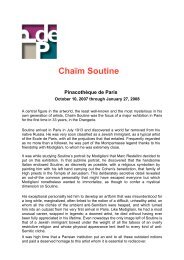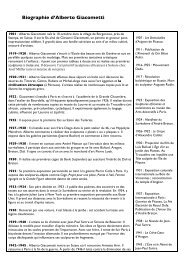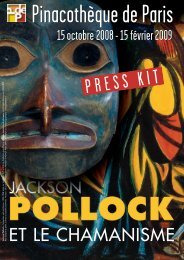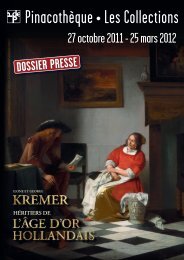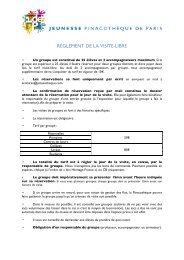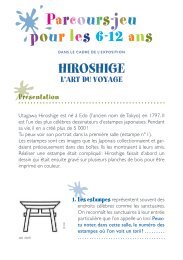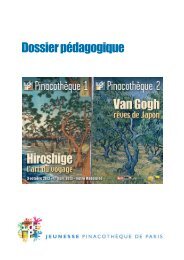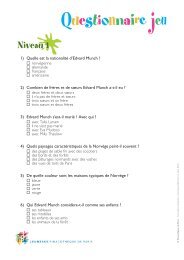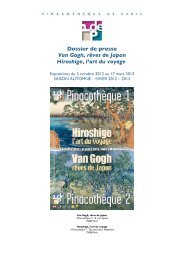Download - Pinacothèque de Paris
Download - Pinacothèque de Paris
Download - Pinacothèque de Paris
You also want an ePaper? Increase the reach of your titles
YUMPU automatically turns print PDFs into web optimized ePapers that Google loves.
outlines that embody he whimsical, child-like style of Paul Klee. A year later, his<br />
portrait types are replaced by fairy-tale inspired subjects, which he surrounds<br />
with an array of surrealist flora and fauna. In August of 1949, Lichtenstein is<br />
inclu<strong>de</strong>d in a group show at the Chinese Gallery in New York; the gallery<br />
typically shows the work of the American Abstract artists as well as Chinese<br />
classical pieces.<br />
Birds and insects are prominently featured in Lichtenstein’s surreal-inspired<br />
paintings by 1950. Knights and mai<strong>de</strong>ns, castles, dragons and medieval saints<br />
replace those subjects, ren<strong>de</strong>red in muted pinks, blues and mauves around<br />
1951. Carved wood totems and playful assemblages <strong>de</strong>picting kings, horses<br />
and warriors ma<strong>de</strong> from metal and found objects such as screws and drill<br />
buffers are shown with his paintings in April of 1951 at the Carlebach Gallery,<br />
Lichtenstein’s first solo show in New York City. In June, his contract is terminated<br />
at OSU, and he and his family move to Cleveland where Isabel’s work as a<br />
contemporary interior <strong>de</strong>corator can expand and Lichtenstein begins a series of<br />
ad hoc commercial engineering and drafting jobs.<br />
At the beginning of 1952, Lichtenstein joins the stable of artists at the John Heller<br />
Gallery in New York and shows mischievous, flatly patterned renditions of<br />
prominent nineteenth-century American genre paintings. Cowboys and Native<br />
American motifs are another prominent subject of Lichtenstein’s during his<br />
pre-Pop period. Like much of Lichtenstein’s production they are featured in a<br />
variety of mixed media-oils, pastels, watercolors, ink, pencil and in woodcut or<br />
linoleum prints. He invents a rotating easel so he can paint upsi<strong>de</strong>-down and<br />
si<strong>de</strong>ways. He wins several awards for works he submits to regional and<br />
national juried print and sculpture competitions. His works are exhibited at<br />
Heller and in Cleveland at the Art Colony Gallery. In 1954, his first son, David,<br />
is born in Cleveland. Around 1955, he returns to the i<strong>de</strong>a of assemblage with<br />
abstract wall constructions of painted plywood, string and canvas. In 1956 his<br />
second son, Mitchell, is born.<br />
In the fall of 1957, Lichtenstein accepts an assistant professorship at the State<br />
University of New York in Oswego, in northern New York State. His work<br />
becomes more abstract and expressionistic. By 1958, images of Mickey Mouse,<br />
Donald Duck and Bugs Bunny can be <strong>de</strong>ciphered as hid<strong>de</strong>n imagery in some of<br />
the work. Others may have been used as drop cloths and <strong>de</strong>stroyed. His brightly<br />
colored heavily impastoed abstract paintings are shown at the Condon Riley<br />
Gallery in New York in June of 1959.<br />
By 1960, Lichtenstein resigns from his Oswego teaching post to become<br />
14



